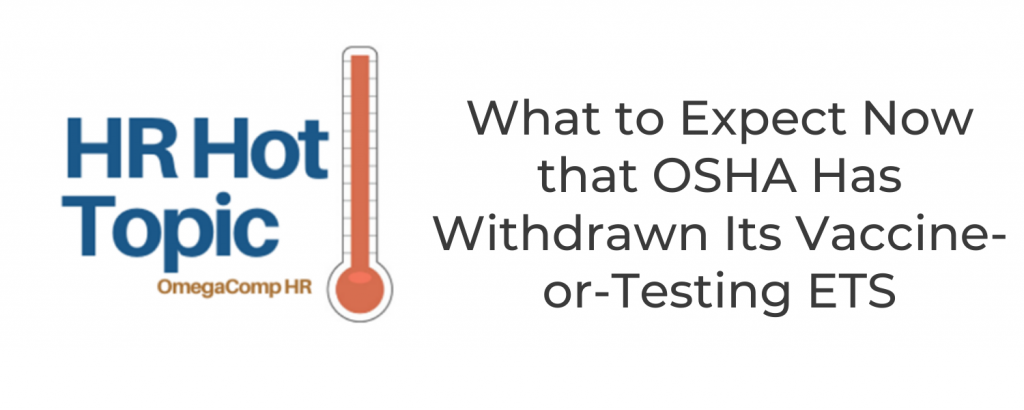HR Hot Topic – What to Expect Now that OSHA Has Withdrawn Its Vaccine-or-Testing ETS
- Admin

The Occupational Safety and Health Administration (OSHA) has withdrawn its emergency temporary standard (ETS), which would have required large businesses to ensure employees are vaccinated against the coronavirus or undergo weekly COVID-19 testing. Nonetheless, the agency is moving forward with its proposal to issue a permanent standard.
Here’s what employers can expect from OSHA in light of the news.
Will OSHA Narrow the Scope?
On Jan. 13, the U.S. Supreme Court halted OSHA’s vaccine-or-testing rule for private businesses with at least 100 employees. “But the ETS wasn’t completely dead,” explained Todd Logsdon, an attorney with Fisher Phillips in Louisville, Ky.
The high court’s ruling meant that OSHA couldn’t enforce the ETS while the 6th U.S. Circuit Court of Appeals considered the merits of lawsuits against the directive.
OSHA officially ended the litigation by withdrawing the ETS effective Jan. 26, but employers should note that the temporary directive served a dual purpose. The ETS also acts as a proposal for a permanent standard, which is separate from the litigation and requires the agency to undergo a formal rulemaking process with a notice-and-comment period.
“OSHA is not withdrawing the ETS to the extent that it serves as a proposed rule,” according to the agency’s Jan. 25 announcement.
“It’s a bit of a zombie rule now,” said Courtney Malveaux, an attorney with Jackson Lewis in Richmond, Va. “It doesn’t completely die; it just takes on different incarnations.”
Eric Hobbs, an attorney with Ogletree Deakins in Milwaukee, noted that OSHA cannot now adopt a regular standard that looks just like the ETS, given the Supreme Court’s decision. “So, the agency is going to have to narrow the scope of the standard, probably focusing on what it deems to be high-hazard industries,” he said.
OSHA noted in a statement that it will prioritize a permanent COVID-19 safety standard for health care workers.
OSHA accepted comments on the vaccine-or-testing proposal through Jan. 19 and received about 121,000 responses, which is “by far the greatest number of comments on a proposed rule OSHA has ever received,” according to Hobbs.
Will OSHA open the record to receive even more comments in light of any changes it intends to make? “That would be wise, but it also would delay publication of a proposed standard,” Hobbs noted. Either way, he said, employers are likely to see some sort of regular COVID-19 standard proposed in 2022, even if the details are not yet clear.
“The only thing we know for sure is that it cannot and will not look just like the ETS OSHA is withdrawing,” he said.
Pay Attention to Continuing Obligations
“Notwithstanding the withdrawal of the [ETS], OSHA continues to strongly encourage the vaccination of workers against the continuing dangers posed by COVID-19 in the workplace,” the agency said.
For now, Hobbs explained, OSHA will continue to inspect employer worksites for COVID-19 safety under the agency’s current standards, including the COVID-19 National Emphasis Program, which targets high-risk industries, as well as housekeeping and respiratory standards and the Occupational Safety and Health Act’s general duty clause.
Under the general duty clause, all employers must provide a work environment that is “free from recognized hazards that are causing or are likely to cause death or serious physical harm.”
Logsdon said employers should pay attention to the COVID-19 guidance that OSHA has put out—much of which incorporates guidelines from the U.S. Centers for Disease Control and Prevention.
“The guidance includes things we’ve all been doing for two years,” he said. OSHA recommends that employers encourage workers to get vaccinated; provide paid time off for vaccination; ensure rooms are properly ventilated; set rules for masking, physically distancing and practicing good hygiene; and have protocols in place for employees to follow if they test positive for COVID-19.
Malveaux said employers should keep an eye on individual states’ plans. OSHA allows states to develop their own workplace health and safety plans, as long as those plans are “at least as effective” as the federal program.
Right now, state officials might not know what they are going to do with their COVID-19 rules when considering the spread of the omicron variant and OSHA’s announcement about the ETS. “We’re all hoping that this is the last spike, but if that’s not the case, states might decide to bring up their own standards again,” Malveaux said.
Because OSHA has withdrawn the ETS, private employers have more flexibility to choose from a broader variety of best practices to address COVID-19 in the workplace, he observed.
“Doing nothing is not an option,” he added. Employers should think about what policies will work best for their business model and culture and consider the tools they have available to combat the coronavirus, such as N95 masks, testing options, remote work and physical distancing measures.
We will continue to provide information and guidance regarding HR-related news. Should you have any questions, please reach out to our Human Resources Department at 916-266-4370.
View original article here: https://www.shrm.org/ResourcesAndTools/legal-and-compliance/employment-law/Pages/OSHA-Vaccine-or-Testing-Directive.aspx
